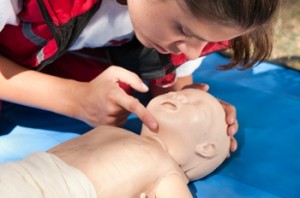First Aid & Safety Tips : How to Measure & Record Vital Signs During First Aid
[media url=”http://www.youtube.com/watch?v=R_iFopwjA5k” width=”600″ height=”400″]Information gathered during the assessment must be analyzed and decisions made based on the best interests of the injured individual. It is especially important to determine whether the situation can be handled on-site or whether referral to a physician is warranted. Although not specifically cited as vital signs but secondarily important to the four main vital signs, skin color, pupillary response to light, eye movement and disposition also may be assessed to determine neurologic function. Abnormal vital signs indicate a serious injury or illness. These are assessed by a clinician or a first aider with sufficient first aid training. You can check on Vancouver first aid and CPR courses.
Firstly, skin color can indicate abnormal blood flow and low blood oxygen concentration in a particular body part or area. Three colors commonly are used to describe light-skinned individuals: red, white or ashen, and blue. In darkskinned individuals, skin pigments mask cyanosis; however, a bluish cast can be seen in mucous membranes (e.g., mouth, tongue, and inner eyelids), the lips, and nail beds. Fever in these individuals can be seen by a red flush at the tips of the ears.

Secondly, the pupils are extremely responsive to situations affecting the CNS. Rapid constriction of pupils when the eyes are exposed to intense light is called the pupillary light reflex. The pupillary response to light can be assessed by holding a hand over one eye and then moving the hand away quickly, or by shining the light from a penlight into one eye and then observing the pupil’s reaction. A normal response would be constriction with the light shining in the eye and dilation as the light is removed. The pupillary reaction is classified as brisk (normal), sluggish, nonreactive, or fixed. The eyes may appear normal, constricted, unequal, or dilated. Eye movement is tested by asking the individual to focus on a single object. An individual experiencing diplopia sees two images instead of one. This condition is attributed to failure of the external eye muscles to work in a coordinated manner. The tracking ability of the eyes can be assessed by asking the individual to follow the examiner’s fingers as they move through the six cardinal fields of vision. The individual’s depth perception can be assessed by placing a finger several inches in front of the individual and then asking the person to reach out and touch the finger. This assessment should be repeated several times, with the examiner’s finger in several different locations. You can try Ottawa for first aid and CPR training.
And last is disposition. As a general rule, the individual should always be referred to the nearest trauma center or emergency clinic if any life-threatening situation is present, if the injury results in loss of normal function, or if no improvement is seen in injury status after a reasonable amount of time. Conditions that are not necessarily life-threatening but are serious enough to warrant referral to a physician for immediate care include: eye injuries; dental injuries in which a tooth has been knocked loose or knocked out; minor or simple fractures; lacerations that might require suturing; injuries in which a functional deficit is noticeable; loss of normal sensation or diminished or absent reflexes; noticeable muscular weakness in the extremities; and any injury if you are uncertain about its severity or nature.
Reference:
Magee, DJ. Orthopedic Physical Assessment. Philadelphia: WB Saunders, Elsevier Science, 2002.
http://downloads.lww.com/wolterskluwer_vitalstream_com/sample-content/9780781784450_Anderson/samples/98853.Ch5.pdf
